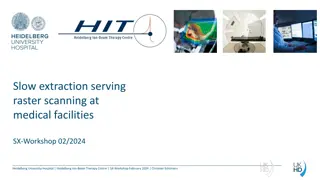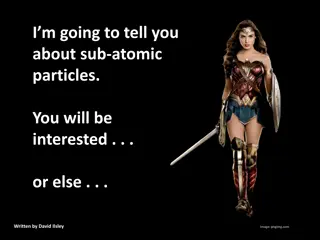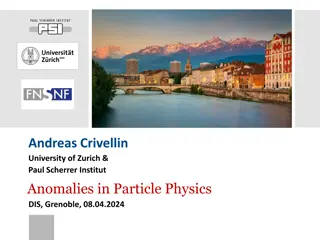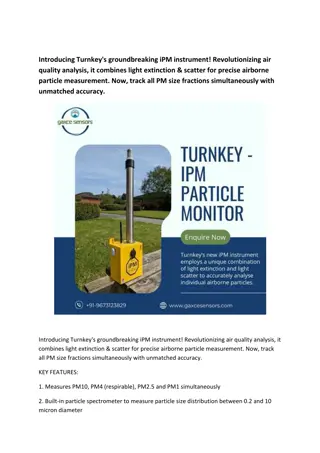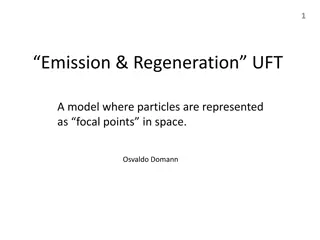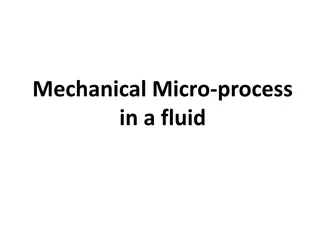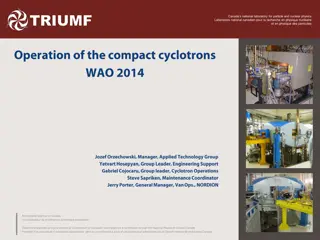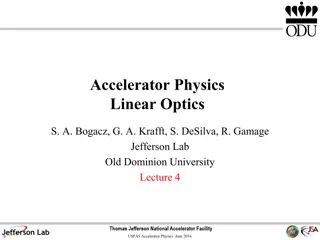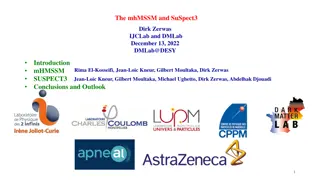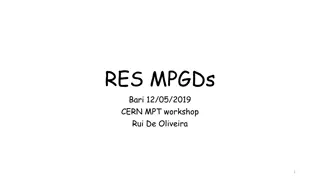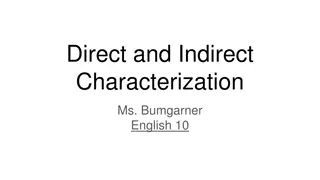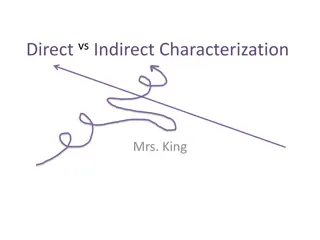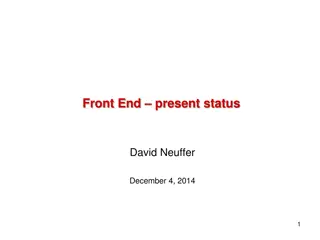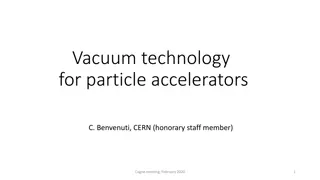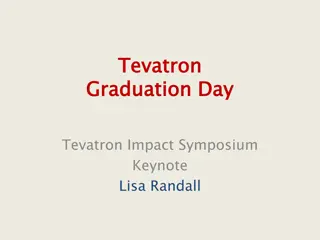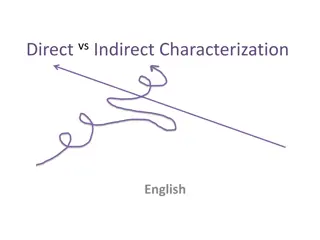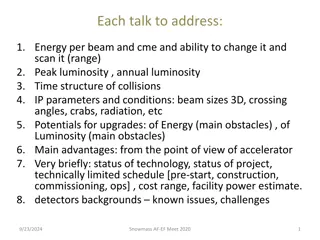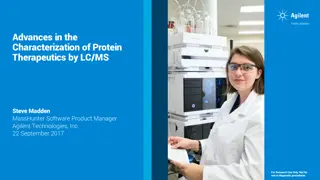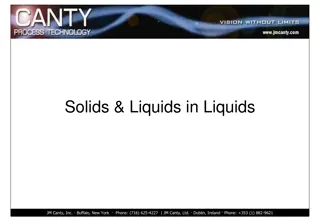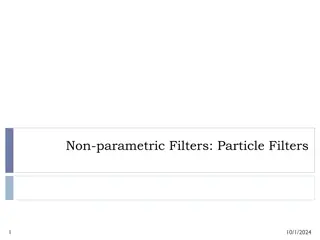[PDF⚡READ❤ONLINE] Cosmology and Particle Astrophysics (Wiley-Praxis Series in As
\"COPY LINK HERE ; https:\/\/getpdf.readbooks.link\/0471970417\n\n[PDF READ ONLINE] Cosmology and Particle Astrophysics (Wiley-Praxis Series in Astronomy & Astrophysics) | Cosmology and Particle Astrophysics (Wiley-Praxis Series in Astronomy & Astrophysics)\n\"\n
0 views • 6 slides
Building a FAIR-Compliant Platform for AI-Ready Data in Particle Accelerators
This content discusses the development of a FAIR-compliant platform for AI-ready data in particle accelerators, highlighting the applications of machine learning in various accelerator facilities like CERN, PETRA-III, NSLS-II, HEPS, and more. It emphasizes the importance of high-quality data in acce
2 views • 25 slides
European Particle Physics Strategy Update & Accelerator R&D Overview
European Particle Physics Strategy updates serve as the cornerstone for long-term decision-making in the field, with a focus on Accelerator R&D for High Energy Physics. The update process involves key questions, R&D strategies for RF technologies, and implementation plans. Approved strategies emphas
7 views • 25 slides
Advances in Particle Therapy: Slow Extraction and Dose Delivery at Medical Facilities
Medical facilities, like Heidelberg University Hospital, utilize advanced techniques such as slow extraction and raster scanning for precise dose delivery in particle therapy. The demands on these facilities include safe and precise beam parameters, uninterrupted therapy sessions, and fast irradiati
2 views • 23 slides
The Evolution of Sub-Atomic Particle Theory
Human pursuit of understanding the universe led to the concept of atoms by Democritus and further advancements in sub-atomic particle theory. From the initial idea of indivisible atoms, to the discovery of protons, neutrons, and electrons, to modern experiments with particle accelerators, the journe
2 views • 24 slides
Anomalies in Particle Physics: Discoveries and Implications
Explore the intriguing anomalies in particle physics discussed by Andreas Crivellin, shedding light on phenomena like the anomalous magnetic moment of the muon, X17 particle, and neutrino anomalies. Discover the latest research findings and potential implications for the future of physics.
0 views • 42 slides
Introducing Turnkey's groundbreaking iPM instrument
\nIntroducing Turnkey's groundbreaking iPM instrument! Revolutionizing air quality analysis, it combines light extinction & scatter for precise airborne particle measurement. Now, track all PM size fractions simultaneously with unmatched accuracy. \nKEY FEATURES:\n1. Measures PM10, PM4 (respirable),
1 views • 2 slides
Understanding Comminution and Particle Size Reduction in Pharmaceutical Processes
Comminution is the process of reducing particle size from larger to smaller particles, crucial in various industries like pharmaceuticals. This operation involves milling, grinding, and size reduction to make raw materials usable. The particle size plays a significant role in pharmaceutical formulat
2 views • 50 slides
Realistic Particle Representations and Interactions in Emission & Regeneration UFT
The presentation explores a model in which particles are depicted as focal points in space, proposed by Osvaldo Domann. It delves into theoretical particle representations, motivation for a new approach, and the methodology behind the Postulated model. Additionally, it delves into particle represent
1 views • 24 slides
Understanding Particle Motion in Fluids: Dynamics and Phenomena
Exploring the intricate dynamics of particle motion within fluids, this content delves into mechanical micro-processes, particle velocity, terminal velocity, flow regimes, and the calculation of drag coefficients. It covers the Stokes region, laminar flow conditions, and considerations for transient
0 views • 28 slides
Understanding Feynman Diagrams in Particle Physics
Feynman diagrams, developed by Richard Feynman in the 1940s, are a graphical technique to represent particle interactions in space-time. These diagrams use lines to depict particles, with fermions moving forward in time and antifermions moving backward. Vertices in the diagrams represent points wher
1 views • 19 slides
Canada's National Laboratory for Particle and Nuclear Physics
The Canadian national laboratory for particle and nuclear physics, operated as a joint venture by a consortium of Canadian universities, accelerates scientific research in Canada. The facility, owned through a contribution by the National Research Council Canada, focuses on advancing science in the
0 views • 21 slides
Linear Beam Optics and Particle Motion in Accelerator Physics
Explore the fundamental concepts of linear beam optics and particle motion in accelerator physics, covering topics such as design trajectory, path length, phase advance, transfer matrix, and more. Understand the intricacies of designing accelerators and the mathematical representations involved in o
0 views • 78 slides
Exploring the mhMSSM and SuSpect3 in Particle Physics
Explore the history and significance of the mhMSSM and SuSpect3 in particle physics, including the development of the MSSM, pMSSM, SuSpect calculator, and key discoveries like the R=+1 particle and relic density studies. Learn about supersymmetric particles, models like mSUGRA and NMSSM, and implica
0 views • 17 slides
Advancing Charged Particle Tracking Resolution in Particle Physics
Exploring the measurement of angle, curvature, and accuracy in charged particle tracking resolution within the CLAS Collaboration. The discussion delves into momentum resolution goals, ideal B-field alignment, and achieving 0.3% accuracy. Details on current momentum resolution, necessary steps for i
0 views • 19 slides
Innovative Resistive Layers and Structures for Particle Detection at CERN
Explore the latest advancements in resistive layers and structures designed for particle detection at CERN. The research covers various types of resistive structures, including GEM and BULK Micromegas, and delves into topics such as spark protection, energy levels, and material vaporization. Detaile
0 views • 39 slides
Understanding Characterization Techniques in Literature
In literature, characterization is essential for creating realistic and relatable characters. Authors use direct and indirect techniques to reveal the personalities of their characters. Direct characterization involves straightforward description of traits, while indirect characterization relies on
0 views • 14 slides
Direct and Indirect Characterization in Literature
The concept of direct and indirect characterization in literature is explored through examples from popular books such as "Artemis Fowl: The Eternity Code" and "The True Confessions of Charlotte Doyle." Direct characterization involves explicit statements about a character's personality, while indir
0 views • 8 slides
Understanding Direct vs. Indirect Characterization in Storytelling
Characterization is key in storytelling to develop characters effectively. Direct characterization involves explicitly stating a character's traits, while indirect characterization reveals traits through actions, thoughts, and interactions. Examples illustrate the difference between the two methods,
0 views • 15 slides
Current Status of Front End Systems in Particle Collider Research
David Neuffer presented the current status of front end systems for particle colliders on December 4, 2014. The presentation covered various aspects like baseline examples, beam characteristics, drift mechanisms, cooling methods, and simulation results. It provided insights into the operational mech
0 views • 15 slides
Understanding Characterization in Literature
In literature, characterization plays a crucial role in developing characters. Direct characterization explicitly describes a character, while indirect characterization allows readers to infer traits through actions, thoughts, interactions, and appearance. Examples and analysis demonstrate how autho
0 views • 5 slides
Vacuum Technology for Particle Accelerators
This presentation covers the importance of vacuum technology in particle accelerators, focusing on particle loss due to collisions with residual gas molecules and the stringent vacuum requirements for storage rings and accelerators. It discusses the impact of circulating beams on vacuum deterioratio
0 views • 37 slides
Celebrating the Impact and Legacy of Tevatron: A Reflection on Particle Physics
Today, we honor the impact and legacy of the Tevatron, highlighting its contributions to science, technology, and creative scientific thinking. From graduation ceremonies to momentous transitions in particle physics, this reflection touches on key experiences, learnings, and insights gained from inv
0 views • 34 slides
Advances in Experimental Particle Physics and Metrology Technologies
This collection of images and text highlights the essential aspects of fundamental physics experiments, particle physics detectors, and the Atlas ITk project. It also focuses on the importance of metrology for physics and satellite experiments, with a specific emphasis on laser technologies. The con
0 views • 11 slides
Understanding Direct vs Indirect Characterization in English Literature
Development of characters, known as characterization, is crucial in storytelling. There are two main ways to characterize: direct and indirect. Direct characterization involves explicitly stating the character's traits, while indirect characterization uses actions, thoughts, and interactions to reve
0 views • 15 slides
Understanding Characterization in Literature
Characterization in literature involves the process through which authors reveal the personalities of characters. There are two main types: direct and indirect. Direct characterization involves the author explicitly telling the audience about the character's traits, while indirect characterization r
0 views • 10 slides
Understanding Transverse Motion in Particle Accelerators
Exploring the formalism and calculations related to transverse motion in particle accelerators, including the Hill equation, transfer matrices, lattice functions, and example drift calculations. The content delves into the mathematical foundations and practical applications of analyzing particle bea
0 views • 16 slides
Understanding Characterization in Literature
Exploring the differences between direct and indirect characterization in literature, this content explains how authors convey character traits through actions, dialogue, thoughts, and interactions. It provides examples and types of indirect characterization, with a focus on speech, thoughts, effect
0 views • 34 slides
Particle Physics Facility Overview and Technical Maturity Assessment
This content delves into various aspects of particle physics facilities, including energy per beam, luminosity, collision time structure, IP parameters, upgrade potentials, advantages, technologies, and project status. It also provides details on facility descriptions, technical maturity, and standa
0 views • 5 slides
Experimental Setup at IP5 for Inelastic Events and Particle Detection
Experimental setup at IP5 involves inelastic telescopes for charged particle detection and vertex reconstruction. The setup includes T1 and T2 telescopes, HF and CASTOR detectors, as well as Roman Pots for measuring elastic and diffractive protons. The TOTEM experiment focuses on proton-proton inter
0 views • 27 slides
Introduction to Particle Physics at U. Wisconsin: Physics 535
Dive into the captivating world of particle physics with Physics 535 at University of Wisconsin. Explore phenomena, delve into Quantum Field Theory and Elementary Particle Physics, and prepare for research work. Engage in in-person lectures supplemented by Zoom for those in isolation. Utilize textbo
0 views • 8 slides
Analysis of Particle Clustering and Reconstruction Methods in Binsong, MA
This weekly report delves into the detailed examination of dEdx in PID, charged particle clustering in the Lcal region, neutral particle reconstruction, and methods involving the Clupatra Track collection and TPCTrackerHits collection. The report showcases the processes, methods, and results related
0 views • 7 slides
Understanding Characterization in Literature
Exploring the concept of characterization through the lens of Squeaky, a dynamic character from 8th grade ELA material. Analyzing direct and indirect characterization techniques and providing text evidence to support the characterization of Squeaky as a passionate, competitive, and intolerant charac
0 views • 23 slides
Advances in Protein Therapeutics Characterization Using LC/MS
This presentation by Steve Madden, MassHunter Software Product Manager at Agilent Technologies, highlights the tools and techniques for protein characterization using LC/MS. The agenda covers topics like intact proteins, peptides, PTMs, glycan profiling, and more, emphasizing the importance of sampl
0 views • 30 slides
Vision-Based Particle Analysis Techniques for Solids and Liquids Measurement
Solids and Liquids in Liquids and Solids in Liquid Measurement are performed by JM Canty, Inc. Their innovative vision-based particle analysis techniques involve dynamic imaging with high-intensity light sources and cameras to measure particle size, shape, and concentration in various liquid systems
0 views • 22 slides
Understanding Particle Filters in Non-parametric Systems
Particle filters, also known as non-parametric filters, are a powerful tool for state estimation in dynamic systems. These filters represent density using a set of samples drawn from the density, known as particles. Through resampling and reweighting, particle filters track the state of a system ove
0 views • 19 slides
Exploring Particle Physics at CERN: A Multinational Conference Experience
Participants from various European cities engage in a video conference at CERN, discussing particle physics topics like pronunciation of particle names, technical terms, and multiple-choice questions. Interactions involve learning about the Large Hadron Collider, particle collisions, and particle de
0 views • 25 slides
Exploring Particles and Detectors in Particle Physics Conference
Delve into the world of particle physics with a focus on particle detectors and pronunciation of particle names. Join a diverse group of participants from various countries as they discuss topics like the Large Hadron Collider and particle interactions. Test your pronunciation skills and learn about
0 views • 25 slides
Performance Studies of dRICH Detector at ePIC Experiment
The Electron-Ion Collider ePIC experiment focuses on the performance studies of the dRICH detector for particle identification crucial in various physics channels. The detector features aerogel optimization, SiPM sensors, and test-beam analyses. Key capabilities include different techniques for part
0 views • 28 slides
Particle Physics Quiz - Test Your Knowledge of the Universe!
Engage in a thrilling particle physics quiz with 7 questions to challenge your knowledge! From understanding mass to energy levels and particle interactions, test your skills and learn fascinating facts. Tick off energy steps for each correct answer as you explore the mysteries of the universe. Expl
0 views • 10 slides
![[PDF⚡READ❤ONLINE] Cosmology and Particle Astrophysics (Wiley-Praxis Series in As](/thumb/21627/pdf-read-online-cosmology-and-particle-astrophysics-wiley-praxis-series-in-as.jpg)


